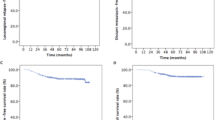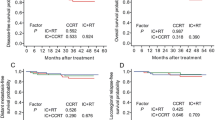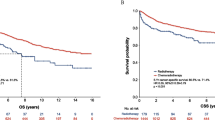Abstract
The objective of the study was to evaluate long-term survival outcomes and toxicity of T4 classification nasopharyngeal carcinoma (NPC) with intracranial extension (IE group) or without intracranial extension (non-IE group) after intensity-modulated radiotherapy (IMRT) using the propensity score matching method. After generating propensity scores given the covariates of age, sex, N classification, and concurrent chemotherapy, 132 patients in each group were matched. The 5-year local failure-free survival rate and the 5-year overall survival rate in the IE group were lower than the patients in the non-IE group (74.6 vs. 88.9 %, p = .008; 51.1 vs. 71.9 %, p = .005). Grade 2 hypothyroidism was more common in the IE group (13.2 vs. 3.4 %, p = .029). For patients with T4 classification NPC after IMRT, patients with intracranial extension need more attention to the thyroid gland function and are more likely to experience local failure and death than patients without intracranial extension.

Similar content being viewed by others
References
Peng G, Wang T, Yang KY et al (2012) A prospective, randomized study comparing outcomes and toxicities of intensity-modulated radiotherapy vs. conventional two-dimensional radiotherapy for the treatment of nasopharyngeal carcinoma. Radiother Oncol 104:286–293
Pow EH, Kwong DL, McMillan AS et al (2006) Xerostomia and quality of life after intensity-modulated radiotherapy vs. conventional radiotherapy for early stage nasopharyngeal carcinoma: initial report on a randomized controlled clinical trial. Int J Radiat Oncol Biol Phys 66:981–991
Kam MK, Leung SF, Zee B et al (2007) Prospective randomized study of intensity modulated radiotherapy on salivary gland function in early-stage nasopharyngeal carcinoma patients. J Clin Oncol 25:4873–4879
Chau RM, Teo PM, Kam MK et al (2007) Dosimetric comparison between 2-dimensional radiation therapy and intensity modulated radiation therapy in treatment of advanced T-stage nasopharyngeal carcinoma: to treat less or more in the planning organ at-risk volume of the brainstem and spinal cord. Med Dosim 32:263–270
Cao CN, Luo JW, Gao L et al (2013) Clinical outcomes and patterns of failure after intensity-modulated radiotherapy for T4 nasopharyngeal carcinoma. Oral Oncol 49(2):175–181
Rosenbaum PR, Rubin DB (1985) Constructing a control group using multivariate matched sampling methods that incorporate the propensity score. Am Stat 39:33–38
D’Agostino RB Jr (1998) Propensity score methods for bias reduction in the comparison of a treatment to a non-randomized control group. Stat Med 17:2265–2281
Chen L, Liu LZ, Chen M et al (2012) Prognostic value of subclassification using MRI in the t4 classification nasopharyngeal carcinoma intensity-modulated radiotherapy treatment. Int J Radiat Oncol Biol Phys 84(1):196–202
Ng WT, Lee MC, Hung WM et al (2011) Clinical outcomes and patterns of failure after intensity-modulated radiotherapy for nasopharyngeal carcinoma. Int J Radiat Oncol Biol Phys 79:420–428
Hung TM, Chen CC, Lin CY et al (2014) Prognostic value of prepontine cistern invasion in nasopharyngeal carcinoma treated by intensity-modulated radiotherapy. Oral Oncol 50(3):228–233
Lee AW, Ng WT, Chan LL et al (2014) Evolution of treatment for nasopharyngeal cancer–success and setback in the intensity-modulated radiotherapy era. Radiother Oncol 110(3):377–384
Liu LZ, Liang SB, Li L et al (2009) Prognostic impact of magnetic resonance imaging- detected cranial nerve involvement in nasopharyngeal carcinoma. Cancer 115:1995–2003
Cheng SH, Tsai SY, Yen KL et al (2005) Prognostic significance of parapharyngeal space venous plexus and marrow involvement: potential landmarks of dissemination for stage I–III nasopharyngeal carcinoma. Int J Radiat Oncol Biol Phys 1:456–465
Wu YH, Wang HM, Chen HH et al (2010) Hypothyroidism after radiotherapy for nasopharyngeal cancer patients. Int J Radiat Oncol Biol Phys 76:1133–1139
Lin Z, Wang X, Xie W et al (2013) Evaluation of clinical hypothyroidism risk due to irradiation of thyroid and pituitary glands in radiotherapy of nasopharyngeal cancer patients. J Med Imaging Radiat Oncol 57(6):713–718
Huang S, Wang X, Hu C et al (2013) Hypothalamic-pituitary-thyroid dysfunction induced by intensity-modulated radiotherapy (IMRT) for adult patients with nasopharyngeal carcinoma. Med Oncol 30(4):710
Author information
Authors and Affiliations
Corresponding author
Ethics declarations
Conflict of interest
None declared.
Rights and permissions
About this article
Cite this article
Cao, Cn., Luo, Jw., Gao, L. et al. Nasopharyngeal carcinoma with intracranial extension in the era of intensity-modulated radiotherapy: case–control study using propensity score matching method. Eur Arch Otorhinolaryngol 273, 2209–2215 (2016). https://doi.org/10.1007/s00405-015-3749-8
Received:
Accepted:
Published:
Issue Date:
DOI: https://doi.org/10.1007/s00405-015-3749-8




